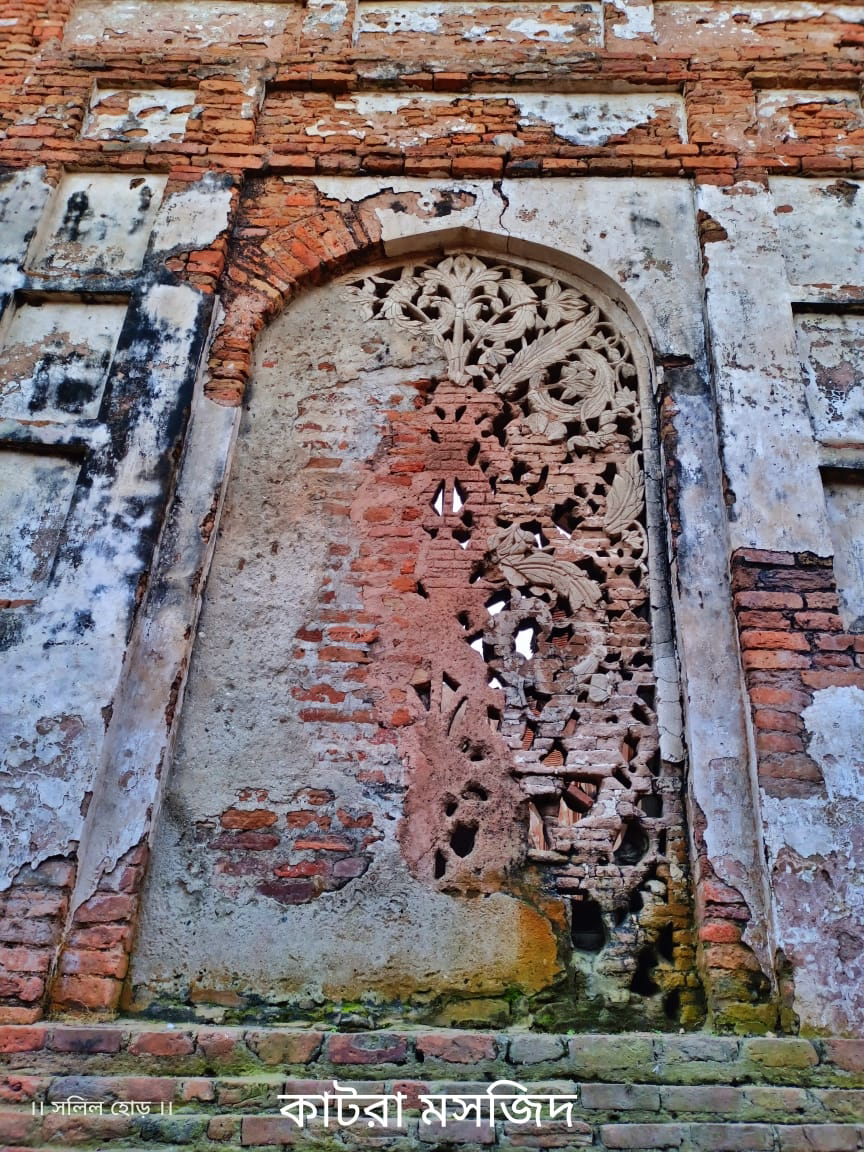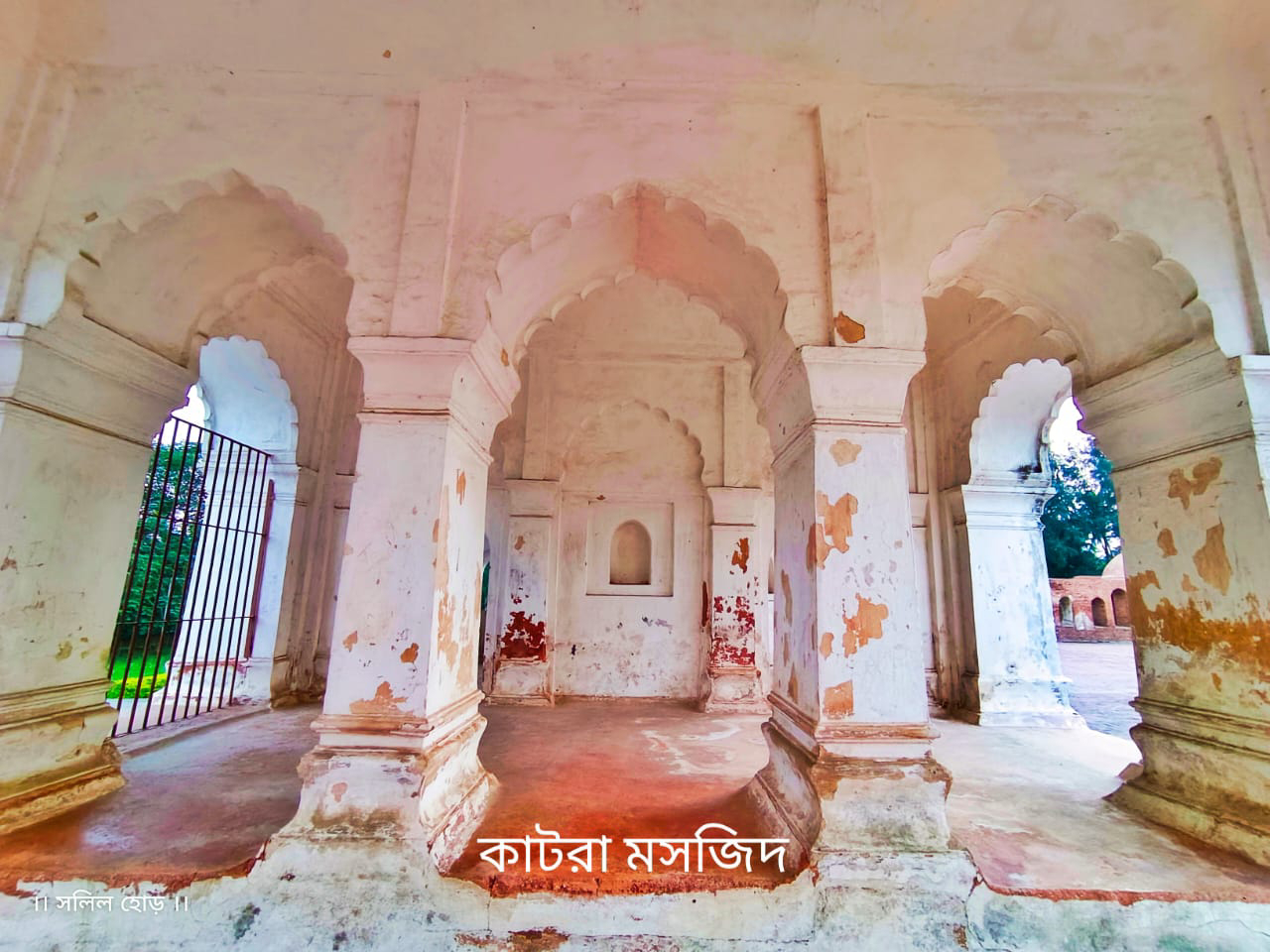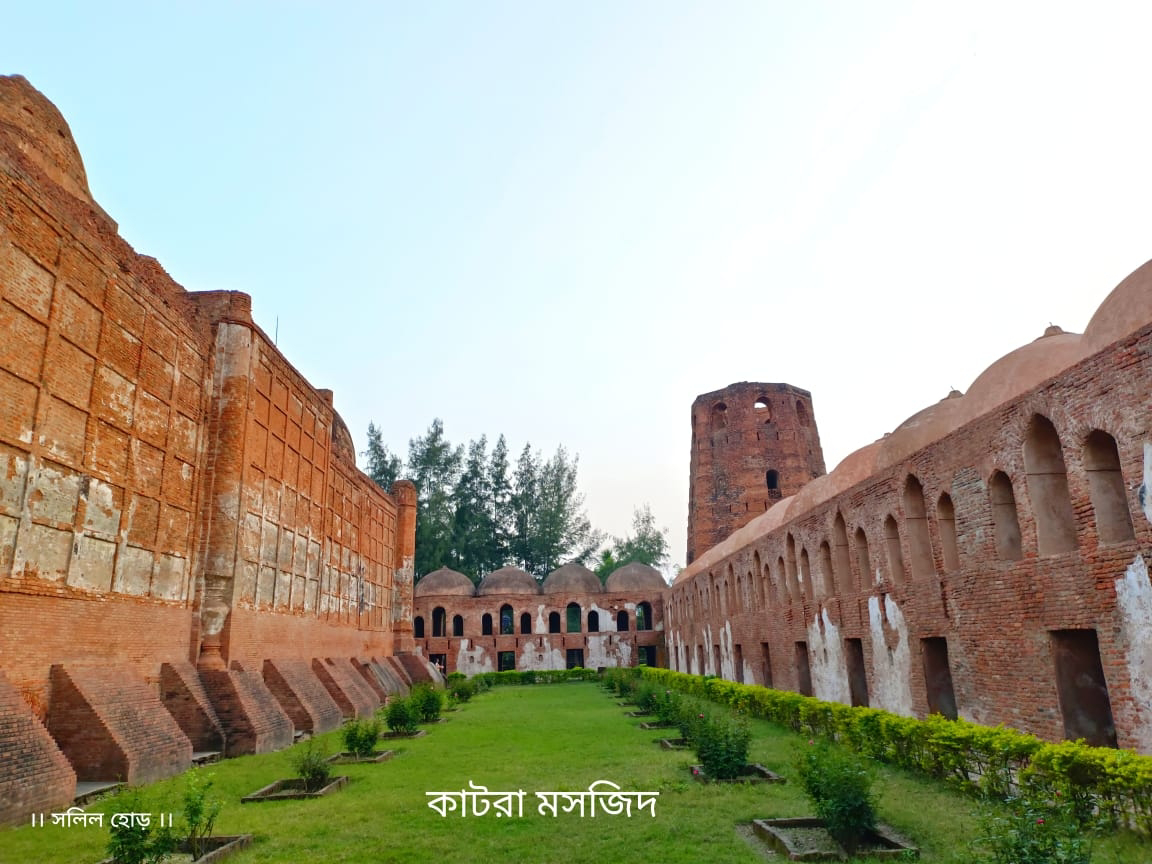কাটরা মসজিদ, মুর্শিদাবাদ (Katra Masjid, Murshidabad)
মুর্শিদাবাদ নামটা শুনলেই আমাদের আসে হাজারদুয়ারীর কথা। ইংরেজ আমলের শুরু হওয়ার আগে, সুবে বাংলার রাজধানী ছিল মুর্শিদাবাদ।
মুর্শিদাবাদ নিয়ে লিখতে শুরু করলে, প্রথমেই বলা উচিত মুর্শিদকুলি খান এবং তার প্রতিষ্ঠিত কাটরা মসজিদ নিয়ে। পূর্বে মুর্শিদাবাদের নাম ছিল মাকসুদাবাদ, পরবর্তীকালে মুর্শিদকুলি খাঁয়ের নামে যা বদলে করে দেওয়া হয় মুর্শিদাবাদ।
মুর্শিদকুলি ছিলেন একজন ব্রাহ্মণ সন্তান, যার জন্ম হয়েছিল বুরহানপুরের এক হিন্দু বংশে। একজন বণিক হাজী ইস্পাহানি তাকে ক্রীতদাস হিসেবে কিনে নিয়ে যান, ইসলাম ধর্মে দীক্ষিত করেন এবং নাম দেন "মহম্মদ হাদী"। পুত্রস্নেহে হাজীর কাছে বড়ো হতে থাকেন তিনি, এবং উচ্চশিক্ষার জন্য তাকে পারস্যে পাঠানো হয়। পরবর্তীকালে ভারতে ফিরে, ঢাকায় তিনি দেওয়ান হিসেবে নিযুক্ত হন, এবং ঔরঙ্গজেব তার নাম দেন করতলব খাঁ। কিছুদিনের মধ্যেই বাংলার সুবাদার আজিম-উশ-শানের সাথে শাসন সংক্রান্ত বিষয়ে মতানৈক্য ঘটলে, করতলব খাঁ তার রাজস্ব বিভাগ, ঔরঙ্গজেব অনুমতি নিয়ে মাকসুদাবাদে স্থানান্তরিত করেন। এর ফলে তার অভিজ্ঞতায় সুবে বাংলার থেকে প্রচুর রাজস্ব সংগ্রহ হতে থাকে, এবং ঔরঙ্গজেব খুবই সন্তুষ্ট হন। কিছুদিনের মধ্যেই সুবে বাংলার রাজধানী ঢাকার থেকে বদল করে মাকসুদাবাদে আনা হয়, এবং করতলব খাঁয়ের নতুন নাম দেওয়া হয় মুর্শিদকুলি খান। এই নামেই মাকসুদাবাদের নাম বদলে রাখা হয় মুর্শিদাবাদ। এরপরে ১৭১৬-১৭ খ্রিস্টাব্দ নাগাদ, তিনি সুবে বাংলার নাজিমের দায়িত্ব গ্রহণ করেন, আর তার সাথে হয়ে ওঠেন বাংলার প্রথম নবাব।
হাজারদুয়ারি থেকে দুই কিমি পূর্বে রয়েছে একটি বিশাল আকৃতির মসজিদ। মুঘল স্থাপত্যরীতিতে মুর্শিদকুলি খানের নির্দেশে তার বিশ্বস্ত কর্মচারী মোরাদ ফরাস এক বৎসরের মধ্যে এই মসজিদ নির্মাণ কার্য শেষ করেন। মসজিদের পশ্চিমদিকে একটি বাজার ছিল, সেখান থেকে এর নাম হয়েছে কাটরা মসজিদ। মসজিদটি তৈরী হয়েছে একটি বিরাট বড়ো চাতালের ওপরে এবং তাকে ঘিরে আছে অনেকগুলো ছোট ছোট ঘর। মসজিদের মূল প্রবেশদ্বারে পৌঁছতে হলে ১৪টি সিঁড়ি বাইতে হয়, যে সিঁড়ির নিচেই রয়েছে ধর্মপ্রাণ মুরশিদকুলি খাঁয়ের সমাধি। প্রবেশদ্বার দিয়ে ঢুকেই রয়েছে বিরাট চত্বর, যেখানে বর্গাকার খোপকাটা রয়েছে (নামাজের সুবিধার্থে)। এখানে বসে অনেক মানুষ একসাথে নামাজ পড়তে পারেন।
মসজিদের পাঁচটি গম্বুজ ছিল, যার মধ্যে ভূমিকম্পের পর এখন শুধু দুটি অবশিষ্ট রয়েছে। মসজিদের প্রবেশের পাঁচটি খিলান রয়েছে, যাতে রয়েছে কালো পাথরের ব্যবহার। মাঝের খিলানের ওপরে একটি ফলকে ফারসি ভাষায় লেখা আছে "আরবের মহম্মদ, যিনি দুই জগতের গৌরব, তাঁর পায়ের ধুলো যেন তাঁদের মাথাতেও পড়ে, যারা তাঁর দরজার ধুলো হতে পারলেন না” - হিজরী ১১৩৭ (অর্থাৎ ১৭২৪ খ্রিস্টাব্দ)।
মসজিদটি দৈর্ঘ্যে ৪০ মিটার এবং প্রস্থে ৮ মিটার। মসজিদের চারদিকে চারটি ২২ মিটার উঁচু মিনার থাকলেও, বর্তমানে ভূমিকম্পের ফলে মাত্র দুটি অবশিষ্ট আছে। এই মিনারে ওঠার জন্য ভিতরে সিঁড়ি থাকলেও, দরজা বন্ধ থাকায় সেখানে ঢুকতে পারি নি।
মসজিদের চারদিকে যে ছোট ছোট ঘরগুলো দেখা যায়, সেগুলো তীর্থযাত্রী এবং কোরআন শিক্ষাত্রীদের জন্য ব্যবহৃত হতো। আজকের তারিখেও, মুর্শিদাবাদের সবথেকে বড় ধর্মীয় স্থাপত্য হলো এই কাটরা মসজিদ।
বর্তমানে এই মসজিদটি ASI এর অধীনে, এবং ঢুকতে দর্শনার্থীদের কোনো টিকিট লাগে না। তবে স্থানীয় গাইডরা প্রচুর ভুলভাল তথ্য দিয়ে থাকেন, যেমন হিন্দু মন্দির ভেঙে এই মসজিদ তৈরি হয়েছিল (সম্পুর্ণ ভুল কথা, কারণ মুর্শিদকুলি খাঁ অনেক মন্দিরের জন্য জায়গা দান করেছিলেন), এবং এই মসজিদের দক্ষিণদিকে একটি শিব মন্দির বানিয়েছিলেন ও সেখানে পুজো করতেন (এই মন্দিরটি একদম হালেই তৈরী হয়েছে, সেটা স্থাপত্যরীতি দেখলেই বোঝা যায়)।
****************************************
Katra Masjid, Murshidabad
As soon as we hear the name Murshidabad, the thought of Hazarduari Palace comes to our minds. Before the beginning of British rule, Murshidabad was the capital of Subah Bangla (Bengal province).
When starting to write about Murshidabad, the first thing that should be mentioned is Murshid Quli Khan and the Katra Masjid established by him. Previously, the name of Murshidabad was Makhsudabad, which was later changed to Murshidabad in the name of Murshid Quli Khan.
Murshid Quli was born into a Hindu Brahmin family in Burhanpur. A merchant, Haji Ispahani, bought him as a slave, converted him to Islam, and named him "Muhammad Hadi." He grew up under Haji's affectionate care and was sent to Persia for higher education. Later, upon returning to India, he was appointed as the Diwan (chief revenue officer) in Dhaka, and Aurangzeb gave him the title of Kartalab Khan. Soon after, due to a disagreement with the Subahdar (governor) of Bengal, Azim-ush-Shan, regarding administrative matters, Kartalab Khan, with Aurangzeb's permission, transferred his revenue department to Makhsudabad. As a result of his expertise, a large amount of revenue started to be collected from Subah Bangla, and Aurangzeb was very pleased. Shortly thereafter, the capital of Subah Bangla was shifted from Dhaka to Makhsudabad, and Kartalab Khan was given the new name Murshid Quli Khan. The name of Makhsudabad was also changed to Murshidabad after him. Subsequently, around 1716-17 AD, he assumed the responsibility of the Nazim (governor) of Subah Bangla, and with that, he became the first Nawab of Bengal.
Two kilometers east of Hazarduari stands a huge mosque. Following Mughal architectural style, Murshid Quli Khan commissioned his trusted employee, Murad Farash, to complete the construction of this mosque within one year. There was a market to the west of the mosque, from which it gets its name, Katra Masjid. The mosque is built on a large platform and is surrounded by many small rooms. To reach the main entrance of the mosque, one has to climb 14 steps, and beneath these steps lies the tomb of the pious Murshid Quli Khan. Entering through the gateway, there is a large courtyard with square indentations (for ease of prayer). Many people can pray together here.
The mosque had five domes, of which only two remain after an earthquake. The mosque has five arched entrances, featuring the use of black stone. On a plaque above the central arch, it is written in Persian: "The dust of the feet of Muhammad of Arabia, the glory of both worlds, may it fall upon the heads of those who could not even be the dust of his door" - Hijri 1137 (i.e., 1724 AD).
The mosque is 40 meters long and 8 meters wide. Although there were four minarets, each 22 meters high, around the mosque, only two remain today due to an earthquake. There are stairs inside these minarets to climb up, but we could not enter as the doors were closed.
The small rooms seen around the mosque were used for pilgrims and Quran students. Even today, the Katra Masjid is the largest religious structure in Murshidabad.
Currently, this mosque is under the Archaeological Survey of India (ASI), and there is no entry ticket for visitors. However, local guides often provide a lot of misinformation, such as claiming that this mosque was built by demolishing a Hindu temple (completely false, as Murshid Quli Khan had donated land for many temples), and that he built a Shiva temple to the south of this mosque and used to worship there (this temple is very recently constructed, which is evident from its architectural style).














Comments
Post a Comment